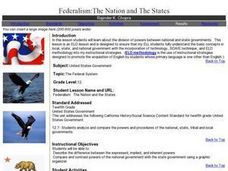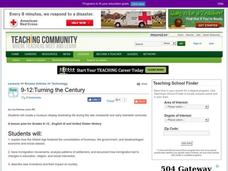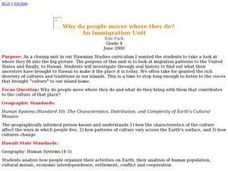Curated OER
Federalism: The Nation and The States
Twelfth graders discuss the division of powers between national and state governments. Groups create a PowerPoint slide representing one of the 3 types of powers.
Teaching Tolerance
The Power of Words: Ethnocentrism and Xenophobia
Students discover articles of current events dealing with the experiences of immigrants in the United States. They brainstorm words used to describe immigrants. They answer questions to end the lesson.
Curated OER
In the Melting Pot
Students work in small groups, each group examining a different aspect of the immigration process (such as visas, work permits, and citizenship exams) or of illegal immigration (such as deportation), to better explain the immigration...
Curated OER
Baltimore as a Port of Entry
Fourth graders explore the Port of Baltimore. In this European immigration to America instructional activity, 4th graders investigate the port as port of entry between 1830 and 1850. Students examine primary documents from selected Web...
Curated OER
The House at 97 Orchard Street
Students examine the living quarters and belongings of immigrant families living in one tenement building spanning the years from 1830 to 1940. They explain how the national background of immigrants added to the "melting pot" of American...
Curated OER
Important Contributions to American Culture
Fifth graders explore the contributions of different cultures to the American landscape. Students work in groups and use a variety of resources to create a presentation about a group that emigrated to America.
Curated OER
Everything was up to date in 1628
Students view a video of Colonial House, a reality series where people lived according to the standards of European immigrants to the U.S. in 1628. In this colonial history instructional activity, students research changes in geographic...
Curated OER
Turning the Century
Students examine the Gilded Age. In this Gilded Age activity, students create a museum of their own showing what life was like in the nineteenth and early twentieth centuries. Students investigate immigration, settlement and how these...
Curated OER
The AME Church in U.S. History
Ninth graders explore the history of the African Methodist Church in the United States. In this African American history lesson, 9th graders discover why the church was founded and research its history and noteworthy members. Students...
Curated OER
Why do people mover where they do?
Young scholars read factual stories of migration to Hawaii, analyze and explain push and pull factors, interview parents about their cultural heritage, identify countried of origin of their ancestors, graph migration patterns on an world...
Curated OER
Wisconsin Snapshots
Fourth graders study Wisconsin's culture and heritage. They research the state's symbols and identify leaves common to the Wisconsin area. They create a leaf booklet and visit the state park. They visit local farms and create nature maps...
Curated OER
The Welcome Wagon
Students demonstrate an understanding of the immigrant experience in their state. In this immigrant lesson, students listen to immigrant speakers to their state and what their lives were like. Students write brief reports or complete...
Curated OER
A Comparative Look at Migrations
Students explore and compare and contrast the migrations of African Americans in the United States in the decades before and after the Civil War.
Humanities Texas
A President's Vision: Lyndon Baines Johnson
Learners take a closer look at the presidency of Lyndon B. Johnson, including the Great Society and the passage of the Voting Rights Act, through image analysis and primary source worksheets.
Curated OER
Injustice on Our Plates: Immigrant Women
Young scholars investigate the plight of undocumented workers. In this social justice lesson plan, students research undocumented workers as well as consumer boycott movements and write about their impressions.
Curated OER
We Have Rights
Students investigate the concept of having rights as citizens. In this citizenship lesson, students examine the rights that are given to citizens of the United States in the Bill of Rights. They draw pictures of eight of their...
Curated OER
Ellis Island: The "Golden Door" to America
Students write a narrative from the perspective of an immigration inspector or European immigrant. In this Immigration lesson, students read an online history of Ellis Island and evaluate its significance by writing answers to discussion...
Curated OER
Ellis Island Online
Students research their ancestors by visiting a number of online resources. They read personal immigration stories and begin creating their own family tree.
DocsTeach
The SS Quanza and European War Refugees
World War II not only resulted in major loss of life, but it also displaced thousands of people. An eye-opening activity uses primary documents to explore the refugee crisis during World War II. Scholars compare the event to modern-day...
US House of Representatives
Exclusion and Empire, 1898–1941
Often forgotten and written off as the model minority, Americans with heritage in Asia and the Pacific Islands have played an essential role in American history, including Congress. Budding historians reclaim history by researching the...
Smithsonian Institution
Racism and Removal: Japanese Incarceration During World War II
During World War II people saw how far the government's control would go, but it was at the expense of its citizens. The resource brings the conditions of Japanese American internment camps to light using primary documents. Scholars...
Angel Island Immigration Station Foundation
Conditions in China: Why Might One Leave Home Forever?
Primary source texts provide scholars with the background information they need to understand why Chinese peasant farmers were driven to emigrate. After underlining keywords, phrases, and/or lines in the texts, individuals craft a...
Anti-Defamation League
What Is the Dream Act and Who Are the Dreamers?
The DREAM Act (Development, Relief, and Education for Alien Minors Act) is the focus of a lesson that asks high schoolers to investigate the act's provisions and read statements by individuals who support and oppose the act. They then...
Teaching Tolerance
Using Photographs to Teach Social Justice | Exploring Identity
Even without captions, photographs can tell amazing, involved, and complex stories. Viewers analyze two photos, consider what the pictures reveal about the subjects' identity, and determine the social justice issues represented in the...

























